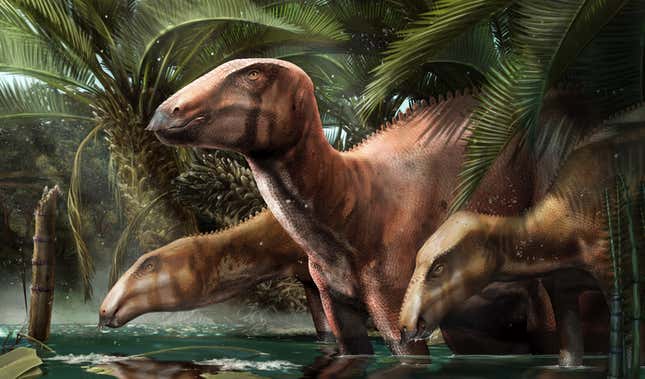
An Italian fishing village near the Slovenian border has yielded a bevy of Cretaceous Period creatures, including dinosaurs, crustaceans, and crocodile ancestors. The paleontological team says the fossil trove tells a different story of the ancient Mediterranean than what’s previously been believed.
The site is a quarry in Villaggio del Pescatore, a northeastern Italian town. Dinosaurs were first found there in the 1980s, and in the years since more and more fossils have come out of the rock. The rock in the quarry is difficult to work with, as heavy machinery is required to extricate the fossils from the stone, and then special acid-baths are necessary to dissolve the rock surrounding the bones. Despite these challenges, paleontologists have now been able to analyze a number of these fossils in depth.
The dinosaurs from the site so far are all Tethyshadros insularis, a species of hadrosaur. Hadrosaurs were herbivores and are colloquially known as the duck-billed dinosaurs. The species was named 15 years ago, but until now the general thinking was that the animals lived about 70 million years ago and were relatively small, based on the complete individual that was previously excavated.
The new research flips that script, based on the unearthing of at least seven and possibly 11 other individuals. The new fossil evidence indicates the animals lived some 10 million years earlier and grew much larger. The highlight from the new bone trove is a large and well-preserved specimen the research team named Bruno, who dwarfs the first dinosaur found on the site, nicknamed Antonio. The team’s research is published in Scientific Reports.
“The newly prepared and studied skeleton, Bruno, appears to be bigger and more massive than the first one, and analyses from the histology show that while the first, smaller individual was a juvenile, the bigger one was older,” lead author Alfio Alessandro Chiarenza, a paleontologist at the University of Vigo in Spain, told Gizmodo in an email.
The exact age of the huge fossil deposit remains unknown. The age of the deposit would shift interpretations of the site, because in the late Cretaceous, different stretches of land around what was then the Tethys Sea were emerging, becoming connected, and submerging. The age of the fossils would indicate when the land that is now Villaggio del Pescatore was actually habitable.

Before, Chiarenza said, consensus was that T. insularis was a product of the island effect, by which small animals on islands will evolve to larger sizes while large animals may evolve to become smaller. (Komodo dragons in Indonesia and dwarf elephants on Malta during the Pleistocene are two such examples.) The discovery of larger dinosaurs indicates that Antonio was not a small adult hadrosaur but a normal-sized youth.
With more data points for the species in hand, the researchers also compared it to other hadrosaurs. This analysis indicated the animal was not the miniature offshoot that was previously thought.
“There is still an additional skeleton waiting in the site to be dug up, Zdravko, which may be potentially even bigger than Antonio and looks sub-complete,” Chiarenza said. “We also have many other animals preserved in the site, from pterosaurs, to crustaceans, to crocodiles, to fish and plants, so we hope some kind of different dinosaur, maybe a complete theropod, could be soon revealed from the site.”
Even if other dinos don’t emerge, the diverse specimens within this quarry are giving paleontologists plenty to study in the years ahead.
More: Stunning Trove of Jurassic Fossils Is Earliest Evidence of Herd Behavior in Dinosaurs